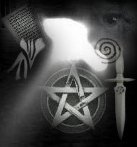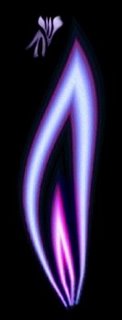Jewitches and Jew-U's also shatter the assumption that those who do not identify with the status-quo are Jewishly unaffiliated.
But here's a question to consider: would a Jewitch or a Jew-U walk into a synagogue and identify herself as Jewish? Or is her Jewish "self" only manifest in those spaces populated by those who share the same kind of pluralistic faith identity? Is there a chance that many of these Jewitches and Jew-U's could, in fact, fully express themselves and find fulfillment in liberal Jewish spaces but are under the assumption that such spaces don't exist? Just how compatible or congruent are these blended identities? Are the Jewitch and Jew-U communities a socio-cultural-spiritual phenomenon, or are they, in fact, transforming religion entirely?
JN asks if a Jewitch would go into a synagogue and identify herself as Jewish - and the answer is, for most of us, including myself - absolutely. In fact, my interest in Jewitchery naturally evolved from my traditional study of Jewish kabbalah from a Chassidic perspective.
Not all Jewitches practice traditional Wicca divorced from traditional Judaism. I don't. I do however, incorporate elements of Celtic witchcraft and Native American shamanism (both also among my natural ancestries along with my Jewish ancestry) into my traditional Jewish kabbalistic practice and study. I love being a Jewitch! It's a life-enhancing blend of all that I am.
Could I be "fulfilled" in a liberal Jewish space? Maybe. Maybe not. In some ways, clearly I am liberal and reconstructionist. On the other hand, I am quite Chassidic in outlook. Most of my kabbalistic study and understanding is based in Chassidic teachings. I also don't "dress" very liberal. For example, I wear long (usually black or dark) skirts peculiar to a more traditional approach. I also wear a Jewitch pentacle and/or a Jewish star along with a witch's pentacle - neither liberal nor orthodox. Consequently, in some ways, my Jewish practice is distinct from both liberal and orthodox practice.
Are Jewitches changing religion entirely? I don't think so. My evolving interest in Jewitchery is in no way a threat to my Judaism. Jewitchery does, however, define for me what it means to be a Jew seriously fulfilling the mitzvah to elevate the sparks of holiness dwelling within my charge. I see Jewitchery as an individuating development and evolution of the Divine Feminine element within the Shechinah. Transforming religion? No. Transformative of feminine consciousness? Yes.


